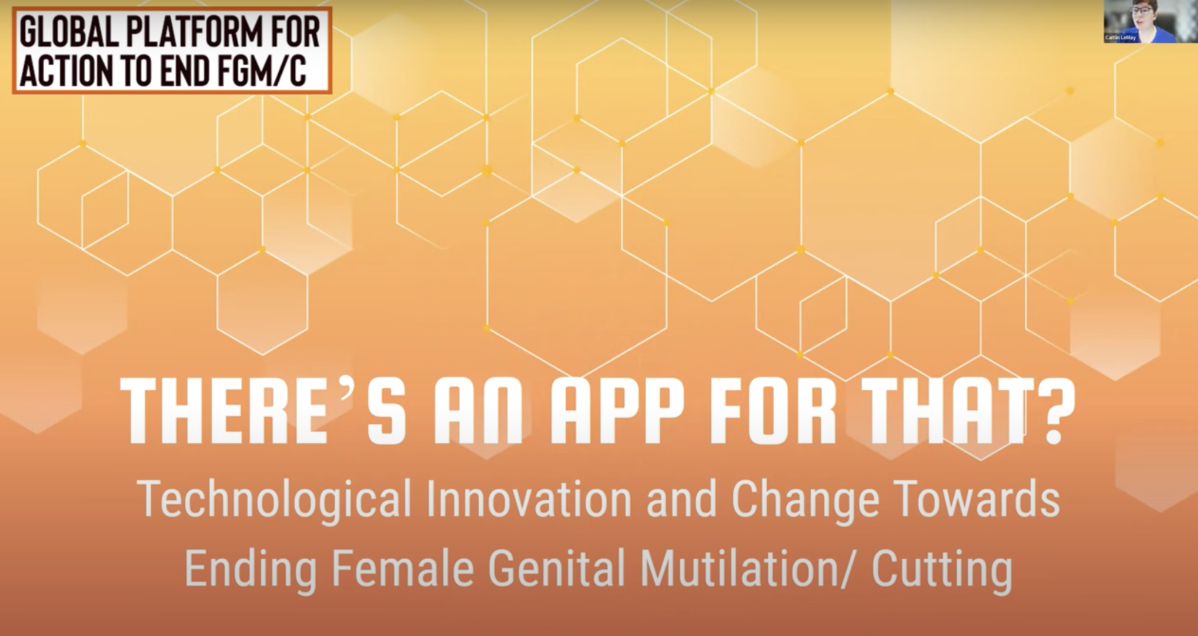By Derrick Simiyu
During this past March 8th, International Women’s Day, I was extremely excited to attend There’s an App For That? Technological Innovation and Change Towards Ending Female Genital Cutting, hosted by the Global Platform for Action to End FGM/C as a parallel event during the United Nations’ NGOCSW67. The webinar explored how technology, internet communication, and the digitalization of awareness raising can help support the elimination of female genital cutting (FGC). The event’s moderators were Caitlin LeMay of The U.S. End FGM/C Network and Esmael Omar of Amref Health Africa.
Speakers for the webinar were leading innovators addressing FGC through technological solutions. The first was Priya Goswami, a Sahiyo Co-founder who has used her background in filmmaking and storytelling to create awareness about the harmful effects of FGC. She also created an app called Mumkin, the Bohra Gujarati word for ‘possible’. The aim of Mumkin was to provide a platform for engaging in difficult conversations around sensitive topics, such as FGC, domestic violence, and consent in relationships.
Priya discussed how Mumkin creates a safe digital space where one can freely speak out without fear of coercement. While the app's features are ethically improved through ongoing research, the safety of the app is of particular significance to the innovators. Mumkin is all about the difficult conversations needed to discover answers to ongoing challenges.
The next speaker was Myriam Mhamedi, a lead communications and campaigns strategist for the End FGM EU Network. Myriam is in charge of implementing the Network's awareness-raising and communication for advocacy initiatives. She discussed how End FGM EU was formed, which is an umbrella network of approximately 35 different organizations working to ensure a joint European action to end FGC.
The presentation by Myriam Mhamedi stood out for me as she showed a network map of Europe that depicts the status of FGC in the different European countries. It is an awesome map that shows law, policy, data and training resources concerning FGC. According to the map, around 600,000 women are living with the consequences of FGC in Europe. It was surprising to me that FGC exists in Europe and has occurred in Europe for a long time; one may falsely think it is only done in Africa and does not happen in other places around the world.
Another innovator was Purity Christine Achieng, a software developer in mobile application development. She co-directed the creation of the iCut app, which allows young women to seek medical and legal aid before or after forcibly undergoing FGC. i-Cut allows users to choose from five main options: help, rescue, report, information on FGC, and donate and feedback. iCut also provides a platform where victims can directly dial emergency numbers for FGC call centers and other pertinent helplines.
Purity Christine explained how the app helps educate the general public about the harmful effects of FGC. She further stated that the use of technology to eliminate FGC is essential because it connects survivors quickly to organizations that can support them on their healing journey associated with FGC. I downloaded the iCut app, and quickly noticed the rescue centers, which I felt fulfilled the requirements of an FGC rescue app. The design was also amiable, in my opinion, making the experience enjoyable as well as informative.
Julie Debois, a UNICEF child protection specialist, was the last speaker on the panel. She developed the Pasha app, which acts as both a responsive and a preventative tool that provides critical information about FGC. I found it very simple to download the Pasha app from the Google Play Store. I think the app is very user-friendly, and I appreciated the special function that allows users to report emergencies involving FGC anonymously if they happen to have no time for signing in.
The innovators also spoke to the challenges they underwent in the process of launching and maintaining their technological tools. The panelist shared that even with these technological tools, there is a challenge via a lack of knowledge in FGC impacted communities that these technologies even exist.
One key takeaway from the event for me was the need to incorporate and use technology in working to end FGC. It is a need that cannot be ignored. Through the use of technology, a bigger percentage of FGC impacted communities can be reached and we can move that much closer to ending FGC globally.

